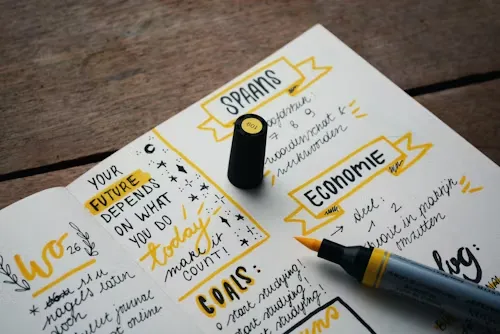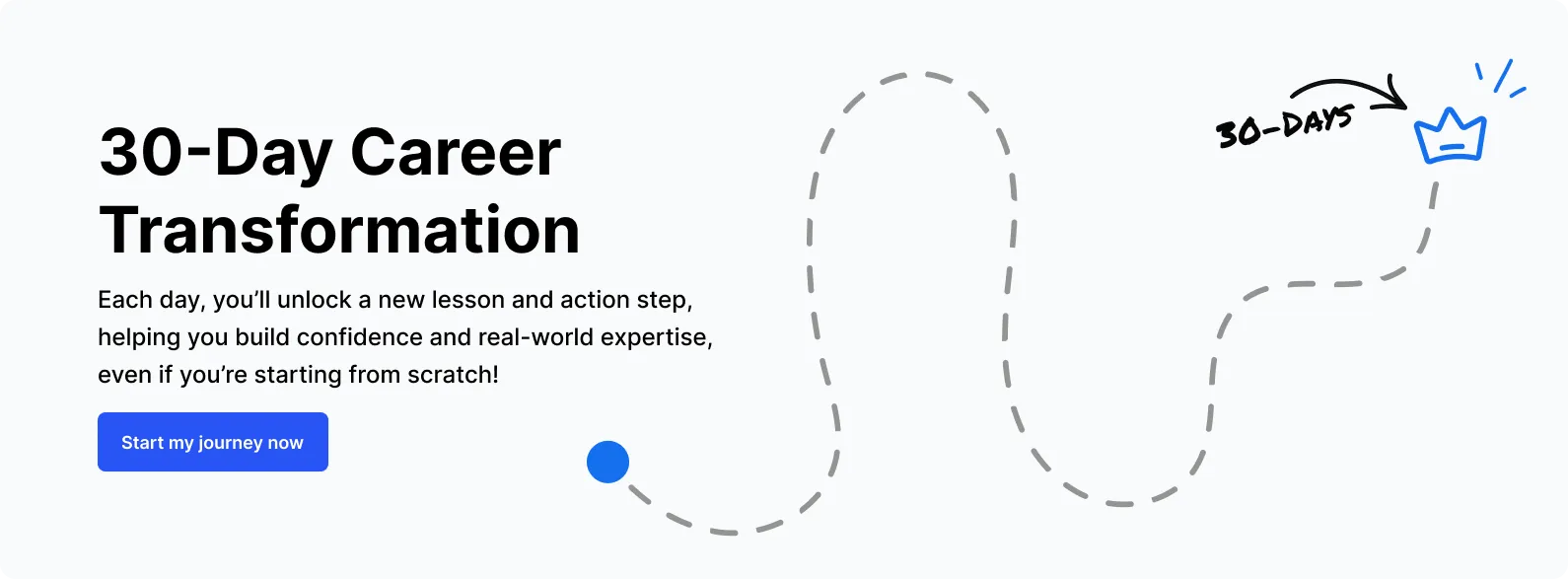6-Step Framework for Navigating Career Transitions
Learn practical strategies to manage change, leverage your strengths, and achieve your career goals. Perfect for professionals seeking a structured approach to successful career transitions.
Table of contents

Learn practical strategies to manage change, leverage your strengths, and achieve your career goals. Perfect for professionals seeking a structured approach to successful career transitions.
Feeling stuck in your current job? Dreaming of a fresh start but unsure where to begin?
Career transitions can be daunting, but they also open doors to new opportunities and growth.
Whether you're transitioning due to industry changes, personal interests, or a desire for better work-life balance, having a clear plan is essential.
It's about taking strategic steps to ensure you're moving in the right direction.
In this guide, we'll explore a 6-step framework to help you successfully transition to a new career. Ready to take the leap? Let’s dive in.
These six real-life stories will guide you through the process, helping you set clear goals, gain new skills, and build a strong professional network.
Follow this framework to ensure a smooth and successful career transition.
Utkarsh Amitabh, CEO of Network Capital, had to decide if his side hustle should become his full-time job.

He spent four years on Network Capital while at Microsoft. Utkarsh questioned why he should quit his stable job for this passion project. And the answer came:
It’s your inner voice whispering that you could do more, be more.
To decide, Utkarsh took two weeks off to focus solely on Network Capital.
That focused effort energized me.
Utkarsh assessed himself and his goals before entering the arena and it proved productive.
He is successful now because of his planning. So, understand your reasons and experiment to gain clarity on your next steps.
Is the change to your passion? Do you have the skills? Is your current job becoming obsolete? These are the questions which will motivate you to take the right steps. Learn how to conduct thorough industry research to uncover job opportunities. Follow these steps to gather valuable insights, analyze trends, and identify potential employers.

Richard Alderson faced a tough period despite having a good job. He felt deeply unfulfilled and longed for work that made a difference.
I had no idea what else I wanted to do and no idea where to start.
He realized his biggest obstacle was himself. His fears and lack of knowledge held him back.
His breakthrough came when he started taking action. Richard enrolled in courses and shadowed friends in different roles.
Action precedes clarity, not the other way round
To navigate your career transition, explore new fields actively. Take courses, shadow professionals, and engage with different industries to find what truly excites you.
In the fast moving tech-world you are a sitting duck if all you do is analyze.
So enroll in a course that teaches you new skills. No-Code skills can be one of them as they teach you technology without having to code.
Learn more about programs at NoCode Institute. Don't let cost hold you back—discover the best funding options to elevate your career today. Explore 16 scholarships and grants offering financial assistance for reskilling programs.

Upskilling and reskilling are critical when transitioning to a new career.
Shikha SK knows this well, having moved from a corporate HR role to an independent consultant and trainer.
Read about current and future trends in the industry. This knowledge helps you focus your learning efforts effectively.
Learning about the new industry is the first step. This includes understanding the skills that are in demand and identifying gaps you can fill.
Highlighting transferable skills is also crucial.
Your transferable skills will help you in a smooth transition.
Emphasizing these skills on your resume and in interviews can make a significant difference. Skills you’ve gained in your current role can often be applied to new fields.
In a career transition, continuous learning is essential. Embrace the process, learn new digital skills, and stay focused on your long-term goals. That’s the mantra.

Rebranding helps others see you in a new light and understand your new professional direction.
Dianne Glavaš experienced this firsthand.
I used to be able to count the number of times I posted on my social media per year on one hand.
She transformed from a rarely active social media user to a prolific personal brand speaker and content creator.
I now, by choice, share a weekly blog, YouTube video, Podcast on personal branding. I now proactively promote myself as a personal brand speaker.
Dianne’s consistent effort in sharing valuable content established her as an expert.
In a career transition, rebranding signals your evolution and commitment.
Ready to rebrand yourself? Learn new skills, find a niche, and promote yourself on social media. Your new you is waiting and so are new employers.
Unlock job opportunities with our guide on top personal branding strategies, including building a strong online presence, networking effectively, and showcasing your unique skills and experiences.
Building connections is a vital step in any career transition. It opens doors to new opportunities and provides support during the change.

Natasha Stanley’s experience exemplifies this perfectly.
The first three months of my career change were among the loneliest of my life.
Feeling isolated, she realized the importance of reaching out and building connections.
Natasha found opportunities by simply engaging with people at events and showing genuine interest.
Deborah and I worked on her business together for six months. This collaboration gave me new skills and a strong stepping stone in my career.
The key to successful networking is authenticity.
Look at how NoCode students build a strong community in our cohort programs while learning indispensable skills.
Simple and honest interactions like these are the cornerstone of networking and can end up being your support systems.
Adjusting to a new role takes time, and it's important to approach this phase with patience.
I'm just a few weeks into my new job at Providence. With each day, I remind myself to keep my own advice in mind when things get confusing or stressful.
Initially, even basic tasks might seem overwhelming. Over time, as you familiarize yourself with your new environment, things will start to make sense.
Alan suggests it typically takes three to six months to feel comfortable in a new job.
He conducted a LinkedIn poll which resulted with 90% of respondents indicating it takes a few months to a year to adapt fully.

Stick with the transition unless you encounter serious issues. Patience is key, and enduring the initial discomfort usually leads to a successful adjustment.
Several factors can impact your transition, including onboarding effectiveness, relocation stress, and support from colleagues.
Whether you're in a virtual or in-person environment also plays a role.
Expect a transition period of three months to a year. Monitor your progress and seek feedback to ensure you're on the right path.
Enhance your career prospects with our tips for developing a growth mindset, including embracing challenges, learning from feedback, and continuously improving your skills and knowledge

Navigating a career transition involves balancing personal and professional challenges, embracing new roles, and practicing patience.
By following the strategies outlined—drawing boundaries, prioritizing tasks, and seeking support—you can make this shift smoother and more manageable.
At NoCode Institute, our comprehensive no-code training programs can give you confidence in navigating career changes. Our courses are designed to help you build valuable tech skills without needing to code.
Plus, you build a strong network with your peers and may find yourself transitioning into a workplace with one of your friends.
Ready to embrace your career transition? Explore our programs at NoCode Institute today and take the first step toward a more fulfilling career!
Looking to re-invent yourself and turn your talent into a career? Stay up to date with the latest.